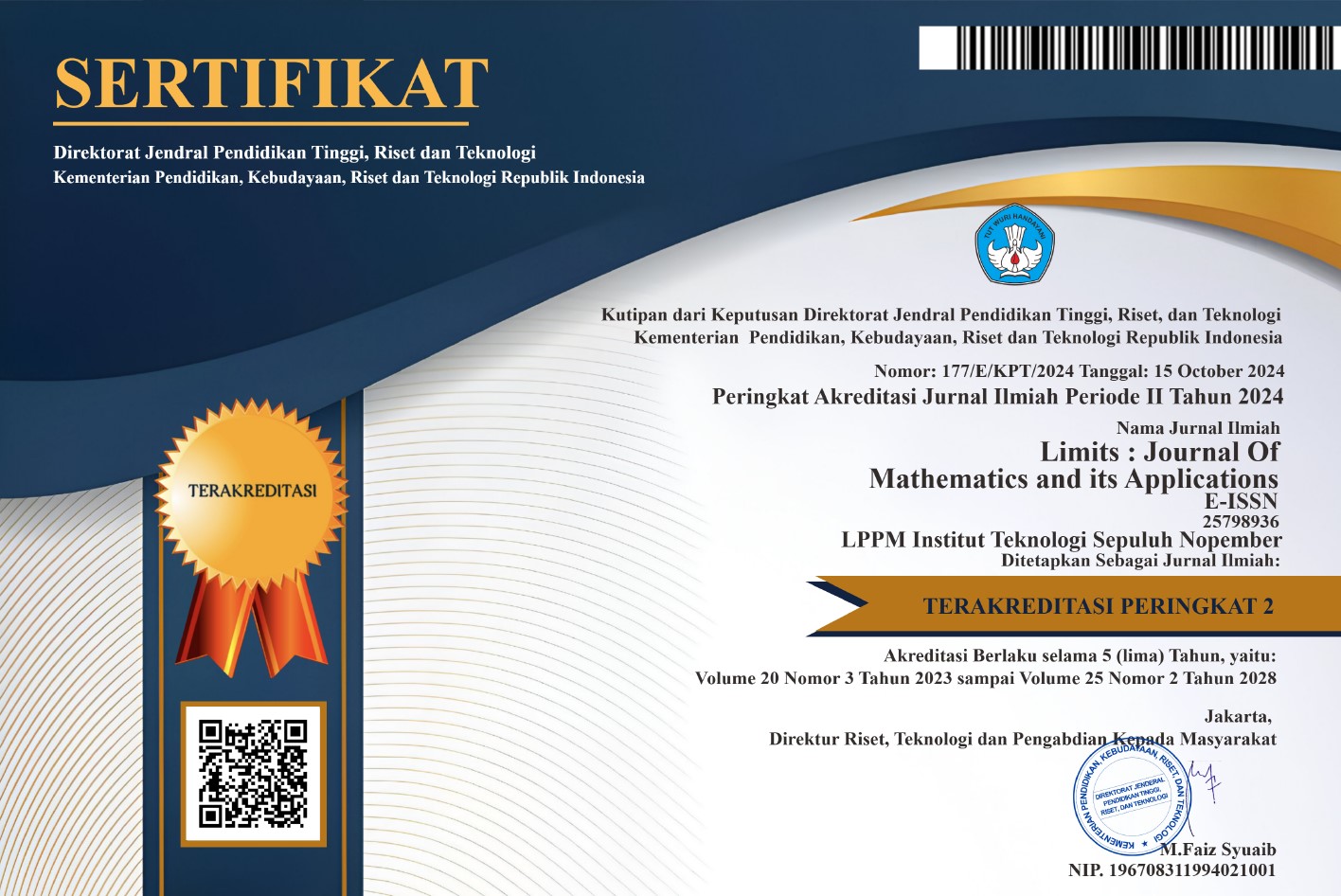Perbandingan Metode GARCH, LSTM, GRU, dan CNN pada Peramalan Volatilitas Kurs
DOI:
https://doi.org/10.12962/limits.v22i1.3384Keywords:
Convolutional Neural Network (CNN), Gated Recurrent Unit (GRU), Generalized Autoregressive Conditional Heteroscedasticity (GARCH), Long Short-Term Memory (LSTM), VolatilityAbstract
Currency volatility is an important aspect of time series data analysis in economics and finance. This study aims to compare the performance of four methods: Generalized Autoregressive Conditional Heteroscedasticity (GARCH), Long Short-Term Memory (LSTM), Gated Recurrent Unit (GRU), and Convolutional Neural Network (CNN), in predicting the volatility of the Rupiah against the US Dollar. The data used is daily exchange rates from January 2015 to March 2024. The evaluation is conducted by calculating the Root Mean Square Error (RMSE) and the percentage of actual values within a 95% confidence interval on training and testing data. The results indicate that LSTM achieves the lowest RMSE, with values of 5.30E-05 on training data and 2.50E-05 on testing data, demonstrating high accuracy in capturing non-linear patterns and long-term fluctuations. GRU records the highest percentage of actual values within the confidence interval, at 90.32% for training data and 91.72% for testing data, reflecting superior consistency compared to other methods. Meanwhile, GARCH shows competitive performance but lacks robustness on testing data. CNN exhibits the lowest performance, with high RMSE and a low percentage of data within the confidence interval. Overall, GRU emerges as the best method, offering an optimal balance between predictive accuracy and consistency, making it a reliable tool for modeling exchange rate volatility in high-volatility scenarios. Consequently, GRU is utilized for forecasting exchange rate volatility for the next 30 days. These findings contribute to the selection of appropriate methods for modeling exchange rate volatility, particularly amidst global market uncertainty.
Downloads
References
P. A. Supriati and N. L. P. Wiagustini, “PENGARUH VOLUME PERDAGANGAN TERHADAP VOLATILITAS (Studi pada Bursa Efek Indonesia dan New York Stock Exchange),” E-Jurnal Manaj. Univ. Udayana, vol. 8, no. 4, p. 2438, 2019, doi: 10.24843/ejmunud.2019.v08.i04.p20.
L. K. Sari, N. A. Achsani, and B. Sartono, “Pemodelan Volatilitas Return Saham: Studi Kasus Pasar Saham Asia Modelling Volatility of Return Stock Index: Evidence from Asian Countries,” J. Ekon. dan Pembang. Indones., vol. 18, no. 1, pp. 35–52, 2017.
L. Aulia, S. Salsabilla, W. Sulistijanti, and A. M. Mardiyah, “Analisis Volatilitas Return Saham PT . Bumi Serpong Damai Tbk . Menggunakan Metode,” vol. 02, no. 02, 2021.
D. H. Ratnasari, Tarno, and H. Yasin, “Peramalan Volatilitas Menggunakan Model Generalized Autoregressive Conditional Heteroscedasticity in Mean (GARCH-M),” J. Gaussian, vol. 3, no. 4, pp. 655–662, 2014, [Online]. Available: http://ejournal-s1.undip.ac.id/index.php/gaussian
S. N. Brilliantya, “Model EGARCH dan TGARCH untuk Mengukur Volatilitas Asimetris Return Saham,” vol. 9, pp. 356–363, 2022.
A. Casolaro, V. Capone, G. Iannuzzo, and F. Camastra, “Deep Learning for Time Series Forecasting: Advances and Open Problems,” Inf., vol. 14, no. 11, 2023, doi: 10.3390/info14110598.
M. Ferian, R. Akbari, B. Rahayudi, and L. Muflikhah, “Implementasi Deep Learning menggunakan Algoritma EfficientDet untuk Sistem Deteksi Kelayakan Penerima Bantuan Langsung Tunai berdasarkan Citra Rumah di Wilayah Kabupaten Kediri,” J. Pengemb. Teknol. Inf. dan Ilmu Komput., vol. 7, no. 4, pp. 1817–1825, 2023.
F. T. Nosa, “Analisis Peramalan Harga Kopi Robusta London dengan Menggunakan Recurrent Neural Network-Long Short Term Memory (RNN-LSTM),” vol. 9, pp. 356–363, 2022.
A. Arwansyah, S. Suryani, H. SY, U. Usman, A. Ahyuna, and S. Alam, “Time Series Forecasting Menggunakan Deep Gated Recurrent Units,” Digit. Transform. Technol., vol. 4, no. 1, pp. 410–416, 2022, doi: 10.47709/digitech.v4i1.4141.
E. Nur Cahyo and E. Susanti, “Analisis Time Series Untuk Deep Learning Dan Prediksi Data Spasial Seismik: Studi Literatur,” J. Teknol., vol. 15, no. 2, pp. 124–136, 2023, doi: 10.34151/jurtek.v15i2.3581.
A. P. Wibawa, A. B. P. Utama, H. Elmunsyah, U. Pujianto, F. A. Dwiyanto, and L. Hernandez, “Time-series analysis with smoothed Convolutional Neural Network,” J. Big Data, vol. 9, no. 1, 2022, doi: 10.1186/s40537-022-00599-y.
R. Reisenhofer, X. Bayer, and N. Hautsch, “HARNet: A Convolutional Neural Network for Realized Volatility Forecasting,” SSRN Electron. J., no. 2009, pp. 1–22, 2022, doi: 10.2139/ssrn.4116642.
J. Li, “The Comparison of LSTM, LGBM, and CNN in Stock Volatility Prediction,” 2022. [Online]. Available: https://www.kaggle.com/c/optiver-realized-volatility-
R. Liu, Y. Jiang, and J. Lin, “Forecasting the Volatility of Specific Risk for Stocks with LSTM,” Procedia Comput. Sci., vol. 202, pp. 111–114, 2022, doi: 10.1016/j.procs.2022.04.015.
Y. Wang, M. Liu, Z. Bao, and S. Zhang, “Short-term load forecasting with multi-source data using gated recurrent unit neural networks,” Energies, vol. 11, no. 5, 2018, doi: 10.3390/en11051138.
J. Hao, X. Bao, S. Guan, and G. Jiang, “Transfer Prediction for the Price Volatility of Carbon Trading with Hybrid Gated Recurrent Unit,” 2023, [Online]. Available: https://papers.ssrn.com/sol3/papers.cfm?abstract_id=4523090
F. Zahroh, Z. Zainuri, and R. Purtomo, “Pengaruh Volatilitas Nilai Tukar terhadap Volume Perdagangan Internasional di ASEAN-3,” e-Journal Ekon. Bisnis dan Akunt., vol. 6, no. 1, p. 28, 2019, doi: 10.19184/ejeba.v6i1.11071.
Kholid Mawardi, “Dampak Nilai Tukar Mata Uang Terhadap Perdagangan Internasional,” Maret, vol. 2, no. 1, pp. 88–102, 2023, [Online]. Available: https://doi.org/10.58192/ocean.v2i2.959
K. Benzid, Lamia; Chebbi, “Impact of Covid-19 Virus on Exchange Rate Volatility: Evidence Through GARCH Model,” SSRN Electron. J., 2020.
J. Hartono, “Teori portofolio dan analisis investasi,” 2022.
J. Y. Campbell, A. W. Lo, and A. C. MacKinlay, “The econometrics of financial markets,” Econom. Financ. Mark., pp. 1–611, 2012, doi: 10.1017/s1365100598009092.
R. F. Engle, “Autoregressive conditional heteroscedasticity with estimates of the variance of United Kingdom inflation,” Econom. J. Econom. Soc., pp. 987–1007, 1982.
Y. Bengio, P. Simard, and P. Frasconi, “Learning long-term dependencies with gradient descent is difficult,” IEEE Trans. neural networks, vol. 5, no. 2, pp. 157–166, 1994.
M. K. Wisyaldin, G. M. Luciana, and H. Pariaman, “Pendekatan LSTM untuk Memprediksi Kondisi Motor 10 kV pada PLTU Batubara,” Kilat, vol. 9, no. 2, pp. 311–318, 2020, [Online]. Available: http://jurnal.itpln.ac.id/kilat/article/view/997%0Ahttps://jurnal.itpln.ac.id/kilat/article/download/997/775
Anishnama, “Understanding Gated Recurrent Unit (GRU) in Deep Learning,” Mediu. Publ. Amerika, 2018, [Online]. Available: https://medium.com/@anishnama20/understanding-gated-recurrentunit-gru-in-deep-learning-2e54923f3e2
Kostadinov, “Understanding GRU Networks,” Mediu. Publ. Amerika, 2017, [Online]. Available: https://towardsdatascience.com/understanding-gru-networks-2ef37df6c9be
S. A. K. Tareen and F. K. Tareen, “Convolutional Neural Networks for Beginners,” SSRN Electron. J., 2023, doi: 10.2139/ssrn.4566310.
R. J. Hyndman and G. Athanasopoulos, “Forecasting:Principles and Practice”.
M. D. Petty, “Calculating and using confidence intervals for model validation,” Fall Simul. Interoperability Work. 2012, 2012 Fall SIW, pp. 37–45, 2012.





